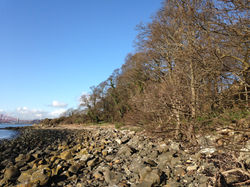Ivy in Early October
Most wild flowers at this time of year have finished flowering and have scattered their seeds for future years. But if you come across a patch of mature ivy where it receives a lot of sun it will be covered in spiky yellow flowers. And, where it is sheltered from the wind, like this patch beside the path in Hopeward Wood, then it is worth taking a closer look.

Don’t be put off by the wasps that are on the flowers, attracted to this abundant source of nectar, there will be other insects also making the most of what is on offer. The wasps are easy to distinguish by their size, appearance and behaviour, and are not interested in stinging any observer, just stocking up on sweet sugars, especially as many of them are males that cannot sting.

But the most spectacular visitors to the ivy at this time of year are the Red Admiral Butterflies. In a year that has seen numbers declining again for many butterfly species, Red Admirals have bucked the downward trend with large numbers being seen all over the UK. The ones we see now are the generation produced from eggs laid on nettles by butterflies that had migrated from the south in the spring. These migrants get as far north as the Shetland Islands but now most of this generation of adults are heading south again to overwinter in warmer climes and in recent years, as winters get warmer, those have included areas of southern England.


While Red Admiral butterflies may be the most colourful, there are lots of other late flying insects to be seen feeding on the ivy. Among the more colourful are hoverflies that mimic wasps or honey bees, and bright metallic blow-flies.












































